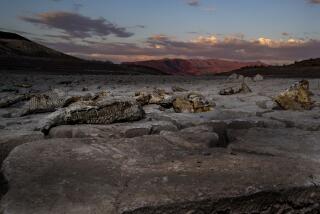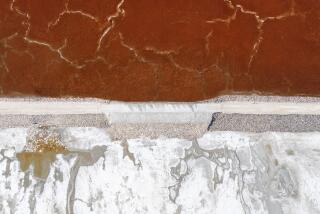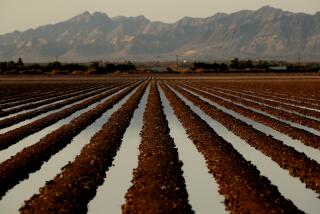Adding up the water deficit
- Share via
Southern Californians are used to turning on the tap, or the sprinklers, and getting the water they want. Their ability to do so depends, in large part, on the Colorado River and the reservoir it feeds, Lake Mead.
In 2008, Tim Barnett and David Pierce, scientists at Scripps Institution of Oceanography, wrote that the lake — a lifeline not just for Southern California but for much of the desert Southwest — would soon teeter at the brink of failure. The Review-Journal in Las Vegas, a city especially dependent on that lifeline, responded with predictable bluster: “We’d love to buy some action on the odds provided by Mr. Barnett and Mr. Pierce. They can name the amount at stake. Are they willing to put their money where their mouths are?”
As far as I know, the Scripps scientists didn’t take advantage of the Review-Journal’s rash offer. Maybe they should have. They knew the odds. So should everyone. There are plenty of reasons the water-happy habits of the modern Southwest are a bad bet:
First, the Lower Basin states of the Colorado River are living beyond their means. The Colorado River Compact of 1922 allocates 7.5 million acre-feet to be divided among California, Arizona and Nevada. Today tens of millions of people from L.A. and San Diego to Las Vegas, Phoenix and Tucson, not to mention agriculture worth billions of dollars, depend on those flows. Trouble is, those Lower Basin states don’t budget for evaporative losses, for their proportionate share of the U.S. treaty obligation to Mexico or for other water losses associated with the plumbing of the river. As a result, they consistently overdraft their account by 1.2 million to 1.3 million acre-feet per year. That’s an annual deficit of about 17%.
For decades the Lower Basin (mainly California) got away with its profligate habits because the Upper Basin — the states upstream of Arizona — developed more slowly; they didn’t have the means to withdraw their share of the river water (theoretically, an additional 7.5 million acre-feet). Not anymore. The Upper Basin now sucks the life out of the river with gusto. No more leftovers.
More bad news for Lake Mead is that the Colorado River Compact incorporates a nettlesome flaw: Its authors divided up more water than the river can provide. Drawing on a small, skewed set of measurements (all that were available in 1922), they thought the river’s average flow was about 17 million acre-feet annually. Now the relevant data set is a lot bigger. The most extensive (and most generous) reconstruction of “paleo” flows, going back more than 1,200 years, points to an average annual flow of only 14.7 million acre-feet. Even Lake Mead, the biggest reservoir in the country, will eventually run dry if its outgo consistently exceeds income.
Water managers have known about these problems for a long time, but they consoled themselves that “augmentation” would provide a solution. Diverting the Yukon River in Alaska and Canada to flow to the Southwest is a good example of augmentation, and once upon a time, people gave this flaky idea serious consideration. Desalination on a massive scale constitutes another form of augmentation, but although desalination is politically more palatable than hijacking rivers, it is similarly costly, as well as gluttonous in its consumption of energy. Augmentation at a scale to bail out the sweltering Sun Belt has been a nonstarter.
As if overuse, over-allocation and a dearth of rivers available for theft weren’t enough to persuade you to make book on Lake Mead’s vulnerability, the climate is changing. OK, so maybe 82 degrees in Los Angeles on New Year’s Day is a fluke. And nearly snowless Sierra Nevada and the Rockies are just weird, and last year’s shoe-melting temperatures and holocaust fires in Arizona, New Mexico and Texas could have happened any time. But really, the Southwest is getting hotter. And hotter means drier even if precipitation stays steady (but don’t bet your house on that) because more heat causes more evaporation. A respected 2005 study predicts that stream flow in the Southwest will probably decline 10% to 30% by mid-century.
Add all of this together and you can see why Barnett and Pierce might have concluded Lake Mead risked failure, which in this context means the lake level drops below Hoover Dam’s lowest outlets. Which means no water goes downstream. All you get is seepage.
The Scripps scientists missed some things in the original study. But eventually they, and a second respected team at the University of Colorado, came to pretty much the same conclusion: After 2026, the risk of failure of Lake Mead, in the words of a member of the second team, “just skyrockets.”
But that is not what is scary.
What’s really scary, according to Jonathan Overpeck, a climatologist at the University of Arizona, “is the possibility that we could trip across a transition into a megadrought.” A megadrought lasts multiple decades. It is the kind of drought that caused Ancestral Puebloan civilizations at New Mexico’s Chaco Canyon and Colorado’s Mesa Verde to collapse and triggered a chain of events that helped do in the Hohokam in central Arizona.
Such droughts, it turns out, are characteristic of semiarid regions around the world, but we’ve not yet seen one in the Southwest during the American era. The droughts of the Dust Bowl days in the 1930s, and the even drier 1950s, were comparative child’s play. The paleo-climatic record tells us our land can get a whole lot drier than anything we’ve ever known.
If/when Lake Mead fails, Phoenix will still drink from the Salt River, but the city is now too big to get by on the Salt alone, and besides, whatever causes the Colorado to shrink will surely shrivel the Salt. So groundwater will have to save the day, but only for as long as it holds out. Los Angeles’ situation is similar. If the Colorado River Aqueduct goes dry, the California Aqueduct and the Los Angeles Aqueduct, which deliver snowmelt from the Sierra, are unlikely to do much better.
Las Vegas, at least, is taking action. Among other desperation plays, it is building Intake No. 3, a kind of bathtub drain at the bottom of Lake Mead, at a cost of $800 million. When the lake level falls below Hoover Dam’s lowest outlets, Las Vegas will still sip the warm tea of the “dead pool.” Las Vegas has put its money where its future is. Although betting on the weather may be akin to playing the lottery, the people responsible for Sin City’s water supply know that a wager on a warming climate is, well, not so much of a gamble.
William deBuys is the author of the newly released “A Great Aridness: Climate Change and the Future of the American Southwest.”
More to Read
A cure for the common opinion
Get thought-provoking perspectives with our weekly newsletter.
You may occasionally receive promotional content from the Los Angeles Times.










